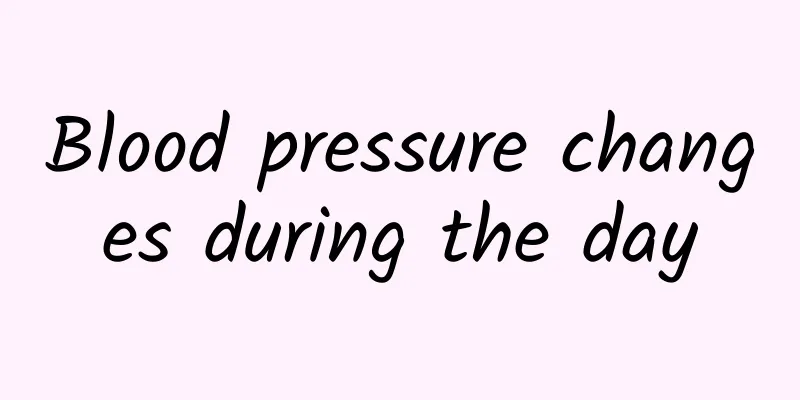Blood pressure changes during the day

|
Blood pressure is an important measure of whether the human body is healthy, especially for middle-aged and elderly people. They must pay close attention to changes in their blood pressure. If there are abnormalities in blood pressure, they must go to the hospital for treatment in time. Because whether it is high blood pressure or low blood pressure, it will pose a certain threat to human health. If not treated in time, it may even threaten human life safety. 1. What is blood pressure The lateral pressure of blood in blood vessels on the blood vessel walls is blood pressure. Since blood vessels are divided into arteries, veins and capillaries, there are arterial pressure, venous blood pressure and capillary pressure. The blood pressure usually referred to is arterial blood pressure. The difference between systolic and diastolic blood pressure is called pulse pressure, or pulse pressure for short. Systemic arterial blood pressure is referred to as "blood pressure" (BP). Blood pressure is the pressure exerted on the blood vessel walls when blood flows in the blood vessels. It is the driving force that pushes blood to flow in the blood vessels. 2. Changes in blood pressure during the day The changes in a normal person's blood pressure during the day can be learned through a non-invasive blood pressure monitor, which regularly measures and records the subject's 24-hour blood pressure changes. Taking 6:00~22:00 as daytime and 22:00~6:00 as nighttime, the blood pressure changes were statistically analyzed and it was found that people with normal blood pressure and those with hypertension had the same blood pressure circadian rhythm. That is, blood pressure is lowest between 0-3 am, and then tends to rise. It rises rapidly after getting up in the morning, reaching the first peak at about 8-9 am. The temperature is basically at a relatively high level during the day. The second peak appears at 17:00-18:00. Blood pressure starts to drop from 18:00 and remains at a relatively low level at night. 3. Significance of blood pressure changes 1. Increased blood pressure: Blood pressure measurements are affected by many factors, such as emotional excitement, tension, exercise, etc. If the standard measurement method is used under quiet and sober conditions, and the blood pressure values on at least three different days reach or exceed systolic pressure 140 mmHg and/or diastolic pressure 90 mmHg, it can be considered that hypertension exists. If only the systolic blood pressure reaches the standard, it is called isolated systolic hypertension. The vast majority of hypertension is primary hypertension, and about 5% is secondary to other diseases, called secondary or symptomatic hypertension, such as chronic nephritis. Hypertension is an important risk factor for atherosclerosis and coronary heart disease, and is also an important cause of heart failure. 2. Lowered blood pressure: Blood pressure below 90/60 mmHg is called hypotension. Sustained hypotension is often seen in serious conditions such as shock, myocardial infarction, and acute cardiac tamponade. Hypotension may also have physical reasons. The patient reports that his blood pressure has always been low. The patient's oral mucosa is partially pale. When the heart contracts and relaxes, the edges of the pale area change from red to white regularly, which is the capillary pulsation sign. |
<<: Why do I hiccup when I move?
Recommend
How to treat chronic eczema
Eczema is already a common skin disease, and it i...
Side effects of Atractylodes macrocephala
The side effects of Atractylodes macrocephala are...
What are the herbs for clearing away heat and detoxification?
Our country's traditional Chinese medicine cu...
What are the effects and functions of white aconite and how to eat it?
Baifuzi is a very common Chinese medicine. This m...
Is it effective to inject fat into the abdomen?
Lipolysis has a good effect on weight loss. For m...
Only when a man gives up this thing can his wife be satisfied
Be firm in your belief and quit smoking as soon a...
What should I do if a boy’s foreskin is too long?
Children do not need treatment before the age of ...
Red blood spots on hands do not hurt or itch
When there are red blood spots on your hands that...
Can sulfuric acid corrode plastic?
Sulfuric acid is one of the three strong acids an...
What kinds of people are not suitable for growing Tiepi Fengdou?
Tiepi Fengdou is a traditional Chinese medicine t...
What are the effects and functions of fresh Dendrobium?
With the continuous improvement of living standar...
How to prevent recurrence of purpuric nephritis
Purpura nephritis is an inflammatory reaction of ...
Why do wounds fester? Beware of bacterial infection
Bumps and minor wounds are normal in daily life. ...
How bad your farts smell can reveal your health
Colorectal cancer is the collective name for colo...
Black wolfberry price
Black wolfberry is also called wild black wolfber...









